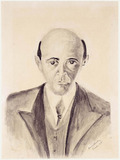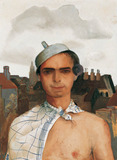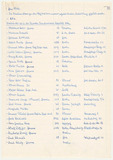Paul Klee: Von der Liste gestrichen (1933)
Paul Klee: Von der Liste gestrichen (1933)
[…] ich bin jetzt ausgeräumt. Morgen Abend verlasse ich wahrscheinlichst diesen Ort. Es kommen dann die schönen Weihnachtstage, wo in jedem Kindskopf Glocken läuten. Ich bin in den letzten Wochen etwas älter geworden. Aber ich will nichts von Galle aufkommen lassen, oder nur humorvoll dosierte Galle. Das gibt’s bei Männern leicht. Frauen pflegen in solchen Fällen der Thränen.
[(…) I've now cleared everything out. Tomorrow night I'll probably be leaving this place. Then there will be the wonderful days of Christmas when children hear nothing but the ringing of bells in their head. I have aged a little in the last few weeks. But I don’t want to be full of bile and invective, well perhaps just a humorous dose of bile. That comes easily to men. In such cases, women resort to tears. (ed. trans.)]
Letter from Paul Klee to Felix and Ephrosina Klee, 22 December 1933
Paul Klee, whose flat in the Bauhaus Meisterhaus complex in Dessau was searched in March 1933 by storm troopers, moved to Düsseldorf on 5 May 1933 with two removal vans, although he had previously been suspended from the Düsseldorf Academy. Paul Klee initially underestimated the political situation and tried to maintain his faith in a normal life. Yet his dismissal from the Düsseldorf Academy in the autumn of 1933 banished all hope. The contracts with the gallery owners in Germany could not be extended, which prompted Klee to seek contracts with galleries abroad. On 23 December, he and his wife Lily Klee (née Stumpf) went into exile in Switzerland. Paul Klee's pictures were shown at exhibitions in Mannheim, Munich, Erlangen, Chemnitz and Dresden as examples of allegedly unsuccessful artworks. Klee's works, which had been defamed as "degenerate art", were removed in the subsequent restructuring of the museums, e.g. in Erfurt.
The picture shown here shows a face reduced to schematic blocks of colour; it can be interpreted as a self-portrait. The black cross, the stamp of censorship and destruction, references Paul Klee's dismissal from the Düsseldorf Academy and his deletion from the list of German artists. The diagonals separate the colour blocks of the face and have a structuring effect. In 1933/1934 Klee used this type of structure several times. Klee created 482 works in 1933, more than in previous years.






